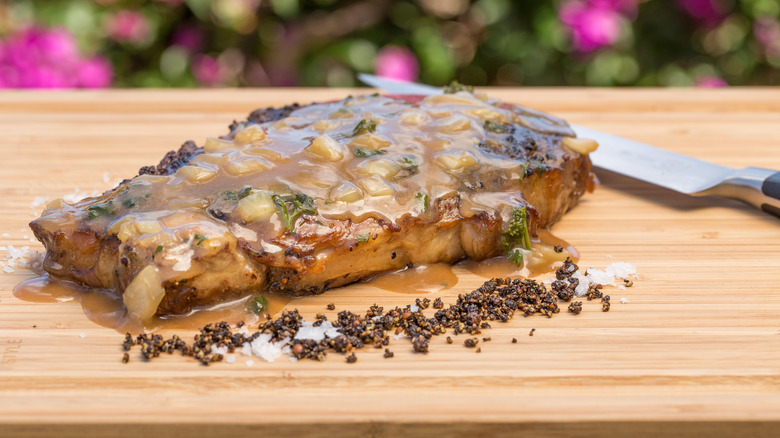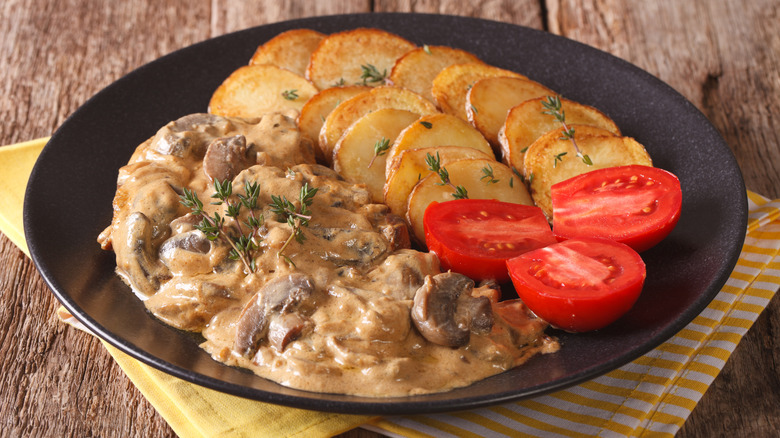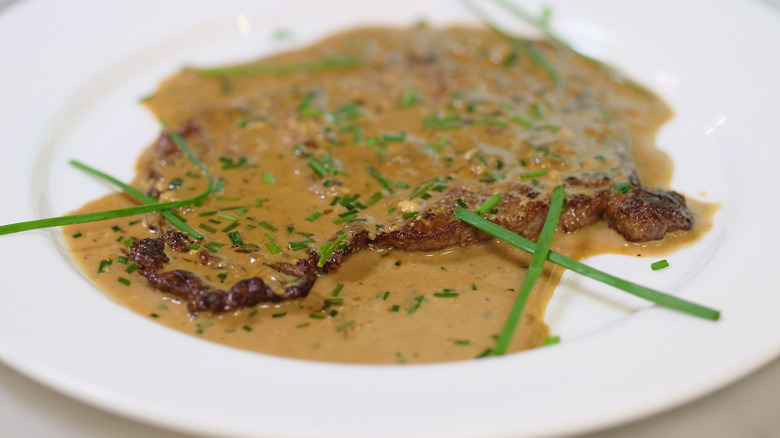Steak Diane May Get Its Name From A Brutal Hunting Goddess
Steak Diane was once synonymous with fine dining. The dish isn't much to look at — browned steak paired with a brown sauce; it's a monochromatic mound brightened only by a sprinkling of chives on top. But Steak Diane's nondescript aspects belie its luxurious nature. Thinly pounded pieces of beef in a rich, booze-laced cream sauce make it easy to see why this dish reigned supreme over New York City's restaurant scene in the 1950s and '60s.
It's a bit of a mystery why Steak Diane fell out of fashion, but the question of its fall pales in comparison to the mystery of its rise. Multiple chefs have claimed they invented Steak Diane, and the origin is unclear. The dish's name has been a particular focus point, and the most widespread theory behind it ties it to Diana, the Roman goddess of wild animals and hunting.
This theory traces back to the legendary chef Auguste Escoffier, whose 1907 cookbook, "Le Guide Culinaire," included a recipe for Sauce Diane, reportedly named for the goddess. It deviates from Steak Diane by including truffles and hard-boiled egg whites and is meant to pair with venison. This may connect to the myth of Diana and Actaeon, in which a hunter catches the goddess bathing. She turns him into a deer, and his hounds eat him. Not the most pleasant thought to have before dinner, but given how different Steak Diane is from Escoffier's recipe, they are probably unrelated. What's more, another Diana is contending for the namesake.
The history of Steak Diane
A common theory says that Steak Diane was invented in 1938 and named after the English actress and aristocrat Lady Diana Cooper. Tony Clerici, owner of London restaurant Tony's Grill, claimed that Diana dined there with her husband, cabinet minister Alfred Duff Cooper. This purportedly happened on the night after Britain signed the Munich Agreement, an ill-fated attempt to appease Nazi Germany. War was looming, and the mood was grim, so Clerici tried to lift everyone's spirits by inventing a new dish on the spot and naming it after the Lady.
Another theory claims that chefs Beniamino "Nino" Schiavon and Luigi Quaglino invented the dish in Belgium. Schiavon would later move to New York City, becoming the maître d' of the Drake Hotel from 1942 until his death in 1968. During this time, he popularized Steak Diane as a hallmark of high society. He vaguely claimed that he named the dish after a wealthy European woman whose surname he didn't identify.
Curiously, there is a restaurant in London called Quaglino's, which has also claimed to be the origin of Steak Diane. Schiavon's old culinary partner, Luigi Quaglino, is sometimes cited as a co-founder of Quaglino's, but the restaurant's website makes no mention of him. In any event, a Quaglino's chef named Bartolomeo Calderoni claimed to have invented steak Diane in the 1930s, but he only made this claim in interviews 50 years after the fact.
What exactly is Steak Diane?
Steak Diane starts with thinly pounded steak, often using filet mignon. Some consider this to be the best cut of steak because it comes from the tenderloin, which is aptly named for its exceptional texture. In many cases, it's a mistake to order tenderloin at a steakhouse as it can lack in flavor. Steak Diane avoids this pitfall by dressing the meat in a rich sauce made from cream and alcohol (typically brandy or cognac, but occasionally wines like Madeira and Marsala), and rounding out the flavor with shallots, Worcestershire sauce, and mustard. Some versions even add mushrooms, making the dish almost like a beef version of chicken Marsala.
At the height of its popularity, Steak Diane was typically flambéed tableside at restaurants. The staff would wheel out a cart with a portable burner to prepare the sauce and, in a grand display of kitchen pyrotechnics, ignite the alcohol to a chorus of oohs and aahs from patrons. This tradition would ultimately play a part in Steak Diane's downfall, as rising rent prices forced restaurants to add more tables to make a profit, leaving little room for tableside theatrics. At the same time, updated building codes have mandated restaurant sprinkler systems, making flaming dishes more risky.
Even without the fire hazard, Steak Diane's rich, fatty nature went against the culinary trends of the late 20th century, so its fate may have been inevitable. Today, your kitchen is probably the easiest place to try Steak Diane.


